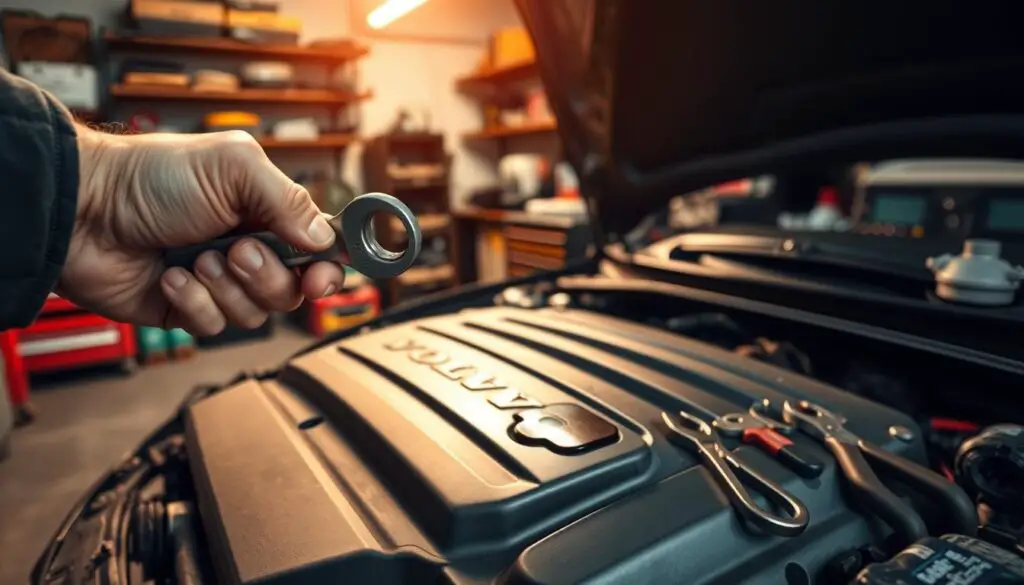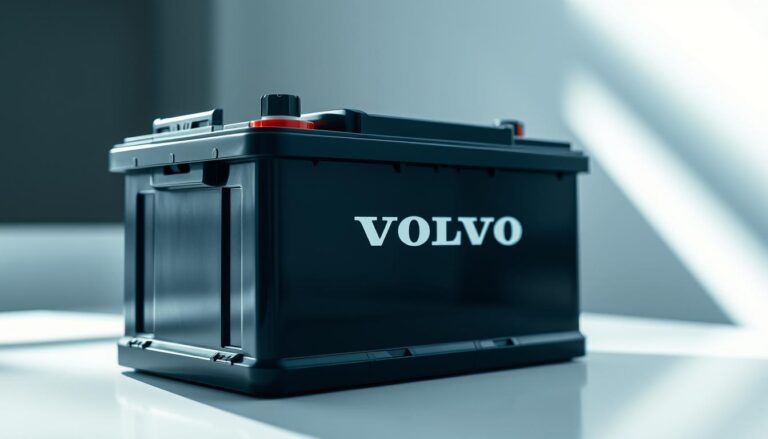A coolant leak in your Volvo can lead to serious engine damage if not addressed promptly. It’s crucial to identify the source of the leak and understand the necessary repairs to maintain your vehicle’s performance and longevity.
Coolant leaks can occur due to various reasons, including worn-out hoses, damaged radiator, or faulty water pump. Understanding these causes is key to finding the right solutions.
Addressing a coolant leak involves diagnosing the issue accurately and applying the appropriate fix. This guide will walk you through the common causes of coolant leaks and provide effective solutions to get your Volvo back in optimal condition.
Key Takeaways
- Identify the source of the coolant leak promptly.
- Understand the common causes of coolant leaks in Volvo vehicles.
- Learn effective solutions to repair coolant leaks.
- Maintain your Volvo’s performance by addressing coolant leaks.
- Prevent serious engine damage by acting quickly.
Understanding Coolant Leaks in Volvo Vehicles
Understanding the signs of coolant leaks is crucial for Volvo owners to prevent overheating and costly repairs. Coolant leaks can lead to significant engine damage if not addressed promptly.
Signs Your Volvo Is Leaking Coolant
Identifying a coolant leak early can save you from expensive repairs. Common signs include visible leaks under the vehicle, low coolant levels, and unusual odors. If you notice any of these signs, it’s essential to investigate further to determine the source of the leak.
Why Coolant Leaks Need Immediate Attention
“Coolant leaks can cause your Volvo’s engine to overheat, leading to costly repairs,” says an expert in Volvo repair. Ignoring a coolant leak can result in irreversible engine damage. For more information on Volvo engine problems, you can visit Volvo D12 Engine Problems. It’s crucial to address any signs of a coolant leak immediately to maintain your vehicle’s health and performance.
Volvo Leaking Coolant but Not Overheating? Common Causes and Solutions
If your Volvo is leaking coolant but not overheating, it’s crucial to understand the underlying causes to prevent potential engine damage. A coolant leak doesn’t always immediately result in overheating due to the vehicle’s cooling system design and the coolant’s role in regulating engine temperature.
Why Coolant Leaks Don’t Always Cause Overheating
The cooling system in Volvo vehicles is designed to maintain optimal engine temperature. Even with a leak, the system can sometimes compensate by adjusting the coolant flow or using reserve capacity. However, this doesn’t mean the leak is harmless.
Several factors contribute to a Volvo leaking coolant without overheating:
- Slow leaks that don’t immediately drop the coolant level significantly.
- A robust cooling system that can temporarily manage with reduced coolant.
- Driving conditions that don’t put extreme demands on the engine.
Long-term Risks of Ignoring Minor Leaks
Ignoring minor coolant leaks can lead to severe long-term consequences, including engine damage and costly repairs. Here are some potential risks:
| Risk | Description | Potential Cost |
|---|---|---|
| Engine Overheating | Prolonged coolant loss can eventually cause overheating. | $500-$1000 |
| Corrosion Damage | Coolant leakage can lead to corrosion in engine components. | $200-$500 |
| Component Failure | Neglecting leaks can result in failure of critical engine parts. | $1000-$3000 |
Addressing coolant leaks promptly is essential to maintaining your Volvo’s health and avoiding expensive repairs down the line.
Diagnosing Coolant Leaks in Your Volvo
Understanding how to diagnose coolant leaks is essential for maintaining your Volvo’s cooling system. Diagnosing a leak early can prevent costly repairs and ensure your vehicle runs efficiently.
Visual Inspection Techniques
A visual inspection is the first step in diagnosing a coolant leak. Look for signs of leakage around the radiator, hoses, water pump, and expansion tank. Check for green or yellow fluid droplets on the ground or on components under the hood. Inspect hoses and connections for any signs of wear or damage.
Pressure Testing the Cooling System
Pressure testing is a more advanced method for diagnosing coolant leaks. This involves pressurizing the cooling system to identify leaks that are not visible during a visual inspection. A pressure tester can be attached to the radiator filler neck to pressurize the system. Listen for the sound of escaping air or look for bubbles in the coolant.
Using UV Dye to Locate Hidden Leaks
Using UV dye is another effective method for locating hidden coolant leaks. The dye is added to the coolant, and then a UV light is used to inspect the cooling system. Leaks will appear as bright spots under the UV light. This method is particularly useful for identifying small or hard-to-find leaks.
| Method | Description | Effectiveness |
|---|---|---|
| Visual Inspection | Looking for signs of leakage around components | High for obvious leaks |
| Pressure Testing | Pressurizing the cooling system to identify leaks | High for hidden leaks |
| UV Dye Testing | Using UV dye to locate leaks under UV light | Very High for small or hidden leaks |
Common Coolant Leak Points in Volvo Models
Understanding the common areas where coolant leaks occur is crucial for Volvo owners to address issues promptly. Coolant leaks can lead to significant engine damage if not identified and repaired in a timely manner.

Radiator and Hose Issues
One of the most common areas for coolant leaks in Volvo models is the radiator and its associated hoses. Over time, the radiator can develop cracks or corrosion, leading to leaks. Similarly, hoses can become brittle or damaged, causing coolant to escape.
Common signs of radiator and hose issues include:
- Visible coolant leaks under the vehicle
- Low coolant levels without an apparent cause
- Discoloration or rust around the radiator and hoses
Water Pump Failures
The water pump is another critical component prone to failure, leading to coolant leaks. A failing water pump can cause the cooling system to lose its ability to circulate coolant effectively, resulting in overheating.
Symptoms of a failing water pump include:
- Coolant leakage around the water pump area
- Unusual noises coming from the water pump
- Engine overheating
Expansion Tank Problems
The expansion tank is a common point for coolant leaks, especially if it’s damaged or cracked. The tank’s plastic material can become brittle over time, making it susceptible to cracks.
| Signs of Expansion Tank Issues | Description |
|---|---|
| Visible Cracks | Cracks or fractures on the tank’s surface |
| Coolant Leaks | Leakage around the tank or its connections |
| Low Coolant Levels | Unexplained drops in coolant level |
Heater Core Leaks
Heater core leaks are another common issue in Volvo models. The heater core can corrode over time, leading to coolant leaks inside the vehicle.
Indicators of heater core leaks include:
- Coolant smell inside the vehicle
- Visible coolant leaks on the passenger floor
- Fogging or misting on the windshield
Model-Specific Coolant Leak Issues
The Volvo XC90, S60/V60 series, and XC60/XC40 each have distinct cooling systems, and understanding these differences is crucial for diagnosing and addressing coolant leaks. While sharing some commonalities, each model’s cooling system has unique characteristics that can affect its propensity for leaks.
XC90 Common Coolant Problems
The Volvo XC90 is known for its robust performance and comfort. However, its complex cooling system can sometimes lead to coolant leaks, often due to radiator and hose issues. Owners should be vigilant about signs of leakage around these areas.
S60/V60 Series Cooling System Weaknesses
The S60/V60 series, while generally reliable, can experience cooling system weaknesses, particularly around the water pump and expansion tank. Regular checks can help identify potential leaks before they become major issues.
XC60 and XC40 Coolant Leak Patterns
The XC60 and XC40, being more modern models, have slightly different cooling system designs. Nonetheless, they are not immune to coolant leaks, often related to heater core issues or expansion tank problems. Understanding these patterns can aid in early detection and repair.
By recognizing the model-specific coolant leak issues associated with their Volvo, owners can take proactive steps to maintain their vehicle’s cooling system, potentially avoiding costly repairs down the line.
DIY Repairs for Volvo Coolant Leaks
DIY repairs for Volvo coolant leaks are achievable with the correct tools and knowledge. Addressing the issue promptly can prevent further damage to your vehicle’s engine and cooling system.

Choosing the Correct Coolant for Your Volvo
Using the right coolant is crucial for the longevity and performance of your Volvo’s engine. Volvo recommends specific coolant types for their models, so it’s essential to consult your owner’s manual or contact a dealership for guidance. Using the incorrect coolant can lead to compatibility issues and potentially damage your engine.
Replacing Hoses and Clamps
Inspecting and replacing hoses and clamps is a fundamental step in fixing coolant leaks. Look for signs of wear, cracks, or damage on the hoses and clamps. Replacing these components is relatively straightforward and can be done at home with basic tools. Ensure you purchase hoses and clamps that are compatible with your Volvo model.
Fixing Expansion Tank Issues
The expansion tank is a common source of coolant leaks. Inspect the tank for cracks or damage. If damaged, replacing the expansion tank is usually the best course of action. Ensure the new tank is properly secured and connected to prevent future leaks.
When to Use Coolant Stop-Leak Products
Coolant stop-leak products can be a temporary solution for minor leaks. However, they are not a substitute for proper repairs. For more information on diagnosing and addressing coolant leaks, you can visit RepairPal for comprehensive guidance.
When to Seek Professional Help
While DIY repairs can be cost-effective, there are situations where seeking professional help is the best course of action for Volvo coolant leaks. Complex repairs, in particular, may require specialized tools and expertise that a professional mechanic can provide.
Complex Repairs Requiring Specialized Tools
Some coolant leaks involve complex repairs that are beyond the scope of DIY fixes. For instance, leaks in the heater core or radiator often require specialized tools to diagnose and repair. In such cases, a professional mechanic with experience in Volvo cooling systems can ensure that the job is done correctly.
Finding a Volvo Cooling System Specialist
To find a reliable Volvo cooling system specialist, look for mechanics who have experience working with Volvo models. Check online reviews, ask for referrals, and verify certifications to ensure you’re getting quality service.
Typical Repair Costs and Warranty Considerations
Repair costs for coolant leaks can vary widely depending on the nature of the leak and the repairs needed. It’s essential to get a detailed estimate from your mechanic and check if the repairs are covered under warranty.
| Repair Type | Average Cost | Warranty Coverage |
|---|---|---|
| Radiator Replacement | $500-$800 | Yes, often covered under basic warranty |
| Heater Core Replacement | $300-$600 | May be covered under extended warranty |
| Water Pump Replacement | $400-$700 | Typically covered under basic warranty |
Conclusion
Addressing coolant leaks in your Volvo is crucial to prevent engine damage and costly repairs. By understanding the common causes and solutions, you can identify and fix issues promptly.
The most common causes of coolant leaks in Volvo vehicles include radiator and hose issues, water pump failures, expansion tank problems, and heater core leaks. Regular inspections and maintenance can help you detect these issues early on.
For more complex repairs, it’s recommended to seek professional help from a Volvo specialist. They can diagnose and fix issues efficiently, ensuring your vehicle runs smoothly. You can find more information on Volvo coolant level sensor problems to further understand the importance of maintaining your Volvo’s cooling system.
By staying proactive and addressing coolant leaks promptly, you can extend the lifespan of your Volvo’s engine and prevent costly repairs down the line. A well-maintained cooling system is essential for the overall health and performance of your vehicle.
FAQ
What are the common signs of a coolant leak in my Volvo?
Common signs include visible leaks, low coolant levels, unusual odors, and potentially, a sweet smell from the coolant.
Why is my Volvo leaking coolant but not overheating?
This could be due to the cooling system’s design, the role of coolant, or a minor leak that hasn’t significantly impacted the system’s functionality yet.
How can I diagnose a coolant leak in my Volvo?
You can start with visual inspection techniques, followed by pressure testing the cooling system, or using UV dye to locate hidden leaks.
What are the common areas where coolant leaks occur in Volvo models?
Common areas include the radiator, hoses, water pump, expansion tank, and heater core.
How do I choose the correct coolant for my Volvo?
Refer to your owner’s manual or consult with a Volvo specialist to determine the correct type of coolant for your vehicle.
Can I fix a coolant leak myself, or do I need professional help?
Minor leaks can be addressed with DIY repairs, such as replacing hoses or clamps, but complex repairs may require specialized tools and professional assistance.
What are the typical repair costs for coolant leaks in Volvo vehicles?
Repair costs vary depending on the source of the leak, the model, and labor costs, but it’s essential to address the issue promptly to avoid more costly repairs down the line.
Are coolant stop-leak products effective for Volvo coolant leaks?
Coolant stop-leak products can be a temporary solution for minor leaks, but they are not a substitute for proper repairs and should be used judiciously.
How can I find a reliable Volvo cooling system specialist?
Look for certified Volvo mechanics or dealerships with experience in cooling system repairs, and check reviews or ask for referrals to ensure you’re getting quality service.



